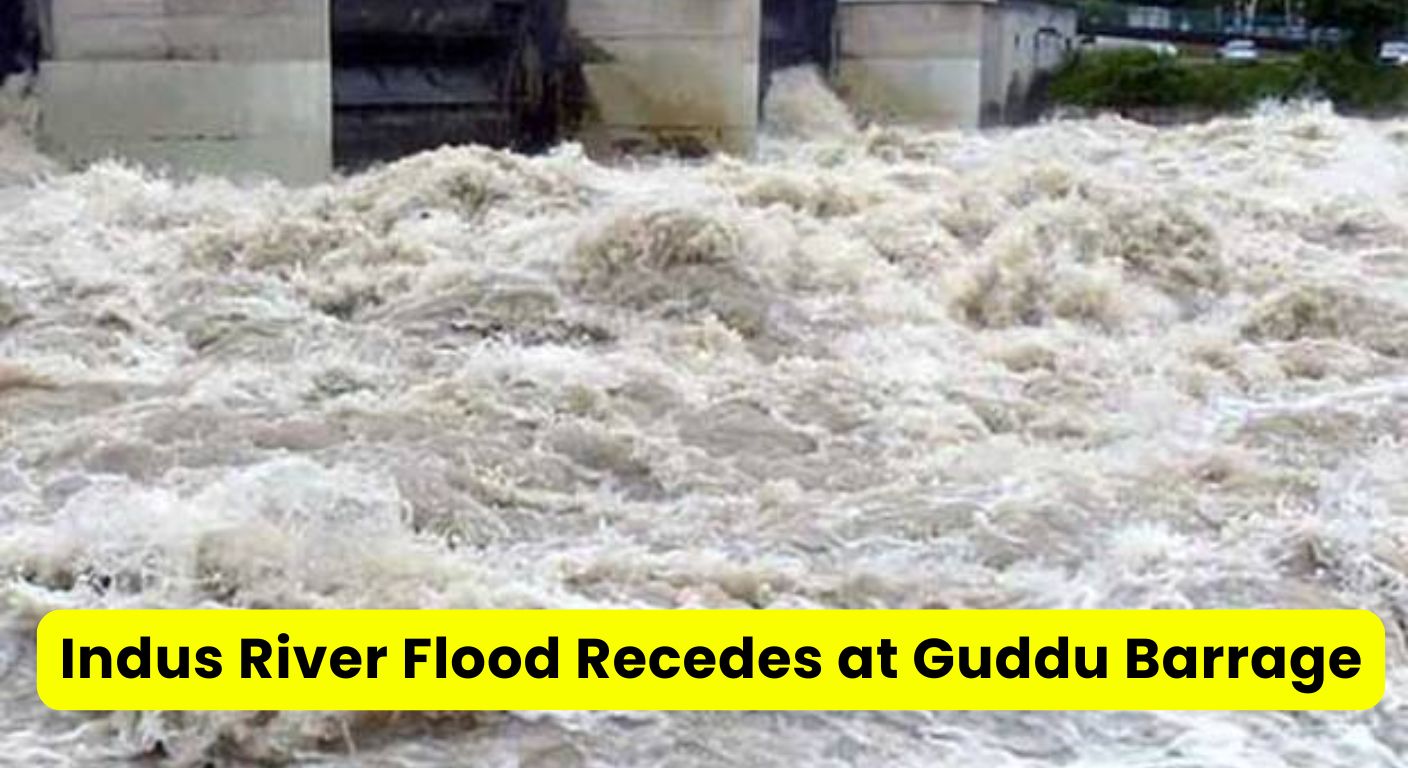Indus River Flood Recedes at Guddu Barrage, Water Level Slowly Dropping

September 18, 2025: The flood situation in the Indus River has started showing signs of improvement as water levels at Guddu Barrage are receding, according to the latest data released by the Sindh Information Department and the Flood Emergency Monitoring Cell on Thursday morning.
Officials confirmed that the water inflow at Guddu Barrage was recorded at 587,983 cusecs, while the water outflow stood at 509,074 cusecs, showing a constant trend of decline in the previously high flood levels. This development has brought some relief to local communities and authorities who had been on high alert for the past several days.
Situation at Sukkur Barrage
At Sukkur Barrage, one of the most critical points for managing floodwater in Sindh, the inflow was recorded at 569,890 cusecs while the discharge was 518,120 cusecs. Experts monitoring the flood situation said that the river flood has already passed its peak at Sukkur and is now receding gradually.
However, they cautioned that while the peak has been crossed, the threat is not over yet. Authorities continue to keep a close watch, particularly in vulnerable districts where breaches in dykes and embankments can still cause damage.
Impact on Naushahro Feroz
In Naushahro Feroz, the river is still in a medium flood situation. The rising water pressure has caused several small dykes, known locally as Zamindari Bunds, to break. These breaches have allowed floodwater to enter nearby agricultural fields, destroying standing crops and submerging farmlands.
Floodwater has also entered low-lying villages along the Indus, forcing families to leave their homes and take shelter on safer ground. According to local reports, several feet of water is standing in the farmlands, cutting off road connections and disrupting land transport between villages.
Farmers in the area expressed deep concern over the loss of crops such as cotton, rice, and sugarcane, which are critical for their livelihood. “This flood has taken away everything,” one villager said, highlighting the economic and social impact of the disaster.
Rising Levels at Kotri Barrage
While Guddu and Sukkur barrages show a declining trend, Kotri Barrage, which lies further downstream, is witnessing a gradual rise in water levels. Officials confirmed that the inflow at Kotri Barrage was recorded at 304,388 cusecs, while the outflow downstream stood at 289,098 cusecs.
Experts believe that water levels at Kotri may continue to rise in the coming days as the floodwaters from upstream barrages move downstream. Kotri is the last major barrage before the Indus River flows into the Arabian Sea, making it a critical point for monitoring the final stages of the flood.
Communities living near Kotri and downstream areas have been advised to stay alert as the river’s flow increases. Authorities have strengthened embankments and placed rescue teams in vulnerable zones to deal with any emergency.
Drop in Flow at Punjnad
On the other hand, the situation at Punjnad Headworks in Punjab has shown a sharp decline in river flow. The inflow there dropped drastically to 138,050 cusecs, a major reduction compared to previous readings. This decline is seen as a positive sign, indicating that floodwaters are slowly passing through the system and reducing pressure on upstream areas.
Agricultural and Human Impact
The flood has left a serious impact on agriculture, villages, and rural communities. Thousands of acres of farmland in Sindh have been submerged, leading to heavy losses for farmers. Crops such as cotton, rice, maize, and sugarcane have been severely affected, causing fears of food shortages and higher prices in the market.
Many villagers have lost not only their crops but also their homes and livestock. Local communities have been forced to migrate temporarily, setting up camps along roadsides and embankments. Relief organizations and district administrations are providing food, water, and medical aid, but challenges remain due to the scale of displacement.
The destruction of road links due to waterlogging has further complicated relief operations. Trucks carrying food and supplies are finding it difficult to reach certain areas where water levels remain high.
Government and Expert Response
The Sindh government has set up monitoring cells at major barrages, including Guddu, Sukkur, and Kotri, to track the flood situation around the clock. Officials from the Irrigation Department have been deployed to inspect embankments and repair breaches.
Experts say that although the peak flood has passed at Guddu and Sukkur, the threat of breaches and localized flooding remains high in Naushahro Feroz, Khairpur, and other low-lying districts. They stressed the need for constant vigilance until the water flow subsides fully.
According to engineers, the flood intensity this year has been less dangerous than the super floods of 2010, but the pressure on the river embankments has still been significant. “We have managed to control the situation at most points, but the damage to agriculture is unavoidable,” one irrigation official said.
Life Along the Indus
For people living along the Indus River, floods are a recurring challenge. Every few years, heavy monsoon rains in the north of the country cause the river to swell, leading to floods downstream in Sindh. While barrages and embankments provide some protection, breaches are common, particularly in agricultural areas where private landowners maintain smaller dykes.
This year, the flood has once again exposed the vulnerability of rural Sindh. Families have moved to higher ground, livestock is being shifted to safer areas, and schools in flood-prone zones have been closed temporarily.
Outlook for Coming Days
With water levels dropping at Guddu and Sukkur, experts expect the flood situation to improve gradually in northern Sindh. However, downstream areas near Kotri Barrage will remain under pressure as more water flows through.
Authorities are urging residents of vulnerable areas to remain cautious, avoid returning to submerged lands too early, and cooperate with rescue teams. Relief operations are expected to continue for several weeks until the water completely drains from the farmlands.
For the agricultural community, recovery will take months, as crops have been destroyed and soil fertility has been affected by standing water. Farmers are calling for government compensation to rebuild their lives and restart cultivation.
Conclusion
The Indus flood has finally passed its peak at Guddu and Sukkur barrages, marking an important turning point in the crisis. While water levels are gradually receding in these areas, the impact on villages, agriculture, and daily life in Sindh remains severe.
The rising water levels at Kotri Barrage and breaches in Naushahro Feroz highlight that the danger is not fully over yet. Authorities remain on high alert, and local communities continue to struggle with the damage left behind.
For now, the receding floodwaters bring cautious optimism, but recovery and rehabilitation will take considerable time and resources. The people of Sindh, especially farmers, are looking towards the government and relief agencies for support as they begin the difficult journey of rebuilding their lives after the flood.






